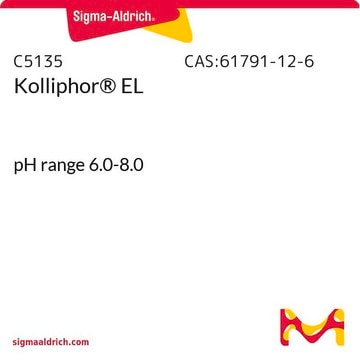15759
Poly(éthylene glycol)-blocage-poly(propylène glycol)-blocage-poly(éthylene glycol)
Synonyme(s) :
Poly(ethylene glycol)-block-poly(propylene glycol)-block-poly(ethylene glycol), Lutrol F68
About This Item
Produits recommandés
Forme
solid
Poids mol.
~7680-9510 g/mol
Composition
oxyethylene, 79.9-83.7%
Impuretés
≤0.25% ethylene glycol and diethylene glycol
≤0.4% total ash
≤1 ppm ethylene oxide
≤1.0% water
≤2 ppm arsenic traces
≤20 ppm heavy metals
≤5 ppm dioxan
≤5 ppm propylene oxide
50-150 ppm butylhydroxytoluene
Résidus de calcination
≤0.30%
Couleur
APHA: ≤120, 50/50 in CH3OH
pH
5.0-7.5 (100 g/L in H2O)
6.0-7.5 (25 g/L in H2O)
CMC
0.48 mM
Température de transition
cloud point >100 °C
HLB
>24
InChI
1S/C3H6O.C2H4O/c1-3-2-4-3;1-2-3-1/h3H,2H2,1H3;1-2H2
Clé InChI
RVGRUAULSDPKGF-UHFFFAOYSA-N
Vous recherchez des produits similaires ? Visite Guide de comparaison des produits
Application
- Stabilizing Function of P 188 in Dermal Formulations: Examined for its stabilizing effects on industrial concentrates of dermal hesperidin smartCrystals, P 188 contributed to enhancing the long-term stability of the formulations, relevant for dermal therapeutic interventions (Romero et al., 2015).
Actions biochimiques/physiologiques
Autres remarques
Informations légales
Code de la classe de stockage
11 - Combustible Solids
Classe de danger pour l'eau (WGK)
WGK 1
Certificats d'analyse (COA)
Recherchez un Certificats d'analyse (COA) en saisissant le numéro de lot du produit. Les numéros de lot figurent sur l'étiquette du produit après les mots "Lot" ou "Batch".
Déjà en possession de ce produit ?
Retrouvez la documentation relative aux produits que vous avez récemment achetés dans la Bibliothèque de documents.
Les clients ont également consulté
Notre équipe de scientifiques dispose d'une expérience dans tous les secteurs de la recherche, notamment en sciences de la vie, science des matériaux, synthèse chimique, chromatographie, analyse et dans de nombreux autres domaines..
Contacter notre Service technique





